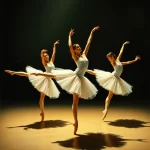Ballet: Flight Pattern (Henryk Górecki, 2017)

Introduction
Ballet, an art form that combines music, dance, and storytelling, has seen numerous masterpieces over the centuries. One such contemporary gem is “Flight Pattern,” choreographed by Crystal Pite with music by Henryk Górecki. Premiered in 2017, this ballet has captivated audiences with its poignant themes and innovative choreography. “Flight Pattern” delves into the human experience of displacement and migration, reflecting on the emotional and physical turmoil faced by refugees.
Historical Background
Creation and Development
“Flight Pattern” was created in a period marked by significant global migration crises. The choreographer, Crystal Pite, drew inspiration from the harrowing images and stories of refugees fleeing conflict and persecution. The ballet does not follow a specific literary source but is instead a response to contemporary social issues. Pite collaborated closely with the composer Henryk Górecki, whose Symphony No. 3, also known as the “Symphony of Sorrowful Songs,” provided the musical foundation for the ballet. The collaboration extended to the dancers and other key figures, ensuring a cohesive and emotionally resonant production.
Premiere and Reception
“Flight Pattern” premiered on March 16, 2017, at the Royal Opera House in London. The initial reception was overwhelmingly positive, with critics and audiences alike praising the ballet’s emotional depth and innovative choreography. Notable early performances included revivals at the Royal Opera House and international tours, solidifying its place in contemporary ballet repertoire.
Synopsis of the Ballet
“Flight Pattern” is a one-act ballet that unfolds over approximately 40 minutes. The narrative is abstract, focusing on the collective experience of a group of people rather than individual characters. The ballet opens with a mass of dancers moving in unison, symbolizing the shared plight of refugees. As the piece progresses, moments of individual struggle and resilience emerge, highlighting the personal stories within the larger context of displacement. The ballet concludes with a powerful image of hope and solidarity, leaving a lasting impression on the audience.
Musical Composition
Composer’s Role
Henryk Górecki, a renowned Polish composer, is best known for his Symphony No. 3, which serves as the musical backbone of “Flight Pattern.” Górecki’s composition, characterized by its haunting melodies and emotional intensity, perfectly complements the ballet’s themes. The symphony’s three movements, each featuring a solo soprano, evoke a sense of mourning and longing, enhancing the narrative’s emotional impact.
Musical Themes and Motifs
The recurring musical themes in Górecki’s Symphony No. 3, such as the lamenting soprano lines and the somber orchestral passages, underscore the ballet’s exploration of loss and hope. The music’s repetitive structures and gradual build-ups mirror the dancers’ movements, creating a seamless integration of sound and motion. The symphony’s use of Polish folk melodies also adds a layer of cultural resonance, connecting the ballet to broader historical contexts of displacement.
Famous Recordings and Performances
Several iconic recordings of Górecki’s Symphony No. 3 have been made, with notable performances by the London Sinfonietta and the soprano Dawn Upshaw. These recordings have been widely acclaimed and have contributed to the symphony’s enduring popularity. In the context of “Flight Pattern,” live performances of the ballet often feature orchestras and soloists who bring Górecki’s music to life, adding to the overall impact of the production.
Choreography and Dance
Choreographer’s Vision
Crystal Pite’s vision for “Flight Pattern” is deeply rooted in her commitment to addressing social issues through dance. Her choreography is characterized by its fluidity, precision, and emotional intensity. Pite’s innovative use of group formations and individual solos reflects the collective and personal aspects of the refugee experience. Her style blends classical ballet techniques with contemporary dance elements, creating a unique and compelling visual language.
Signature Dance Numbers
Key moments in “Flight Pattern” include the opening mass movement, where dancers move in tight formations, symbolizing the unity and struggle of displaced people. Another significant scene is a duet that portrays the intimate bond between two individuals amidst the chaos, highlighting themes of love and resilience. The final tableau, where dancers form a human chain, serves as a powerful symbol of solidarity and hope.
Notable Interpretations
Different productions of “Flight Pattern” have brought unique interpretations to Pite’s choreography. Some have emphasized the ballet’s political message, while others have focused on its emotional and humanistic aspects. These variations demonstrate the versatility and depth of Pite’s work, allowing each performance to resonate with contemporary audiences in different ways.
Characters and Roles
Main Characters
Unlike traditional ballets with defined characters, “Flight Pattern” features an ensemble cast that represents a collective experience. The dancers embody various aspects of the refugee journey, from fear and despair to hope and resilience. This approach allows the audience to connect with the broader themes of the ballet rather than focusing on individual narratives.
Supporting Characters
While there are no distinct supporting characters, certain dancers take on more prominent roles in specific scenes, such as the aforementioned duet. These moments provide a deeper emotional connection and highlight the personal stories within the collective experience.
Famous Dancers
Notable dancers who have performed in “Flight Pattern” include members of the Royal Ballet, such as Marianela Nuñez and Thiago Soares. Their performances have been praised for their technical prowess and emotional depth, contributing to the ballet’s critical acclaim.
Cultural and Artistic Impact
Influence on Ballet and Dance
“Flight Pattern” has had a significant impact on contemporary ballet, inspiring other choreographers to tackle social and political themes through dance. Pite’s innovative use of group dynamics and her ability to convey complex emotions through movement have influenced a new generation of dancers and choreographers.
Cultural Significance
The ballet’s exploration of displacement and migration resonates with current global issues, making it a culturally significant work. “Flight Pattern” has been featured in discussions on the role of art in addressing social justice, and its themes have been explored in various academic and artistic contexts.
Legacy and Revivals
Since its premiere, “Flight Pattern” has been revived multiple times, with each production bringing new insights and interpretations. The ballet’s enduring relevance and emotional power ensure that it will continue to be performed and celebrated for years to come.
Iconic Productions
Historic Productions
The original production of “Flight Pattern” at the Royal Opera House remains one of the most iconic, featuring a stellar cast and innovative staging. Key figures involved in this production include set designer Jay Gower Taylor and lighting designer Tom Visser, whose contributions added to the ballet’s visual impact.
Contemporary Productions
Recent productions of “Flight Pattern” have explored new staging and design elements, reflecting contemporary artistic trends. These adaptations have kept the ballet fresh and relevant, appealing to modern audiences while staying true to Pite’s original vision.
Production Design
The set, costume, and lighting design in “Flight Pattern” play crucial roles in conveying the ballet’s themes. The minimalist set design, combined with evocative lighting, creates a stark and powerful visual landscape. The costumes, designed to reflect the anonymity and universality of the refugee experience, further enhance the ballet’s emotional impact.
Critical Reception and Reviews
Initial Critical Response
Upon its premiere, “Flight Pattern” received rave reviews from critics, who praised its emotional depth and innovative choreography. The ballet was lauded for its timely and poignant exploration of displacement, with many reviewers highlighting Pite’s ability to convey complex themes through dance.
Modern Reviews
Contemporary critics continue to praise “Flight Pattern” for its relevance and emotional power. The ballet’s themes of displacement and resilience resonate with current global issues, making it a powerful and timely work. Modern reviews often focus on the ballet’s ability to connect with audiences on a deep emotional level, ensuring its continued popularity.
Fun Facts and Trivia
Behind-the-Scenes Stories
One interesting anecdote from the production of “Flight Pattern” involves the intense rehearsal process. Crystal Pite worked closely with the dancers to ensure that every movement conveyed the ballet’s emotional weight, often drawing on personal stories and experiences to inform the choreography.
Notable Performers
Famous dancers associated with “Flight Pattern” include Marianela Nuñez and Thiago Soares, whose performances have been widely acclaimed. Their technical skill and emotional depth have brought Pite’s choreography to life, contributing to the ballet’s success.
Trivia
- “Flight Pattern” is one of the few contemporary ballets to address social and political issues directly.
- The ballet’s music, Górecki’s Symphony No. 3, was composed in 1976 but gained widespread popularity in the 1990s.
- Crystal Pite is known for her work with major ballet companies around the world, including the Royal Ballet and the National Ballet of Canada.
Conclusion
Summary of the Ballet’s Importance
“Flight Pattern” is a significant work in the world of dance, addressing contemporary social issues through innovative choreography and powerful music. Its exploration of displacement and resilience resonates with audiences, making it a culturally and artistically important ballet.
Final Thoughts
“Flight Pattern” is a testament to the power of ballet to convey complex emotions and social themes. Crystal Pite’s choreography, combined with Henryk Górecki’s haunting music, creates a deeply moving and thought-provoking experience. For those interested in contemporary ballet and social issues, “Flight Pattern” is a must-see performance.
FAQ
What is the central theme of this ballet?
The central theme of “Flight Pattern” is displacement and migration, exploring the emotional and physical turmoil faced by refugees.
Who are the main characters in this ballet?
Unlike traditional ballets, “Flight Pattern” features an ensemble cast representing a collective experience rather than individual characters.
What is the most famous dance number in this ballet?
One of the most notable scenes is the opening mass movement, where dancers move in tight formations to symbolize the unity and struggle of displaced people.
How long does a typical performance of this ballet last?
A typical performance of “Flight Pattern” lasts approximately 40 minutes.
Are there any modern adaptations of this ballet?
Recent productions have explored new staging and design elements, reflecting contemporary artistic trends while staying true to Crystal Pite’s original vision.
Why is this ballet considered important in the history of dance?
“Flight Pattern” is considered important for its innovative choreography, emotional depth, and timely exploration of social issues, influencing contemporary ballet and inspiring new works.





